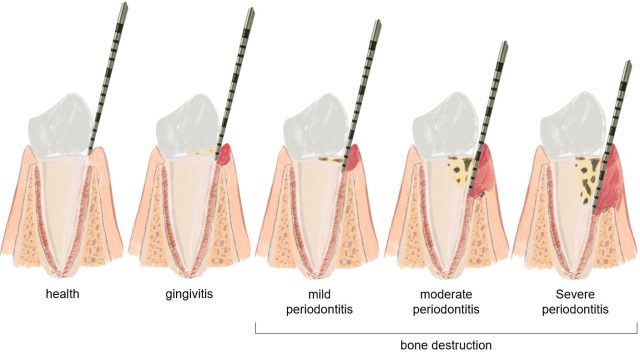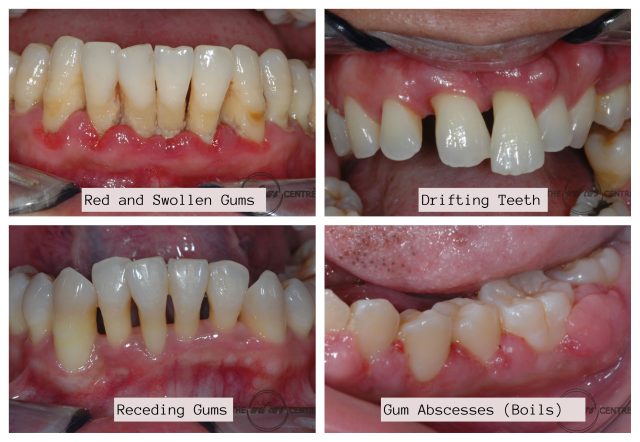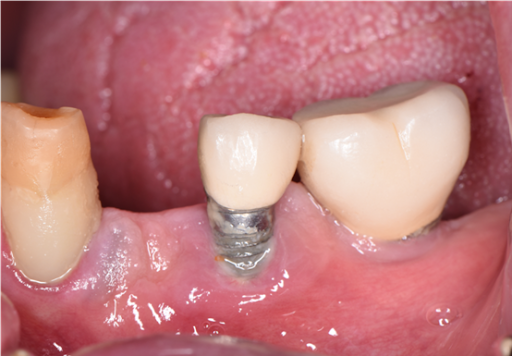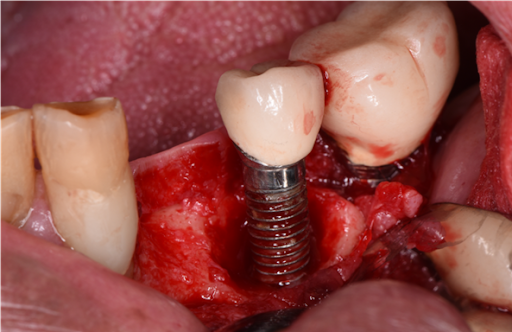The gums and jaw bones form the foundation for our teeth. We need our teeth to maintain a healthy diet and feel good, both of which are important to our physical and emotional well-being.
A common myth is that we lose our teeth as we age, and hence, checkups and regular cleanings are not important. Decay (caries) and gum (periodontal) disease are the most common reasons people lose teeth, and both can be prevented in most cases.
In this article, we’ll discuss gum disease, which is sometimes referred to as the silent gum infection.
What is Periodontal Disease?
Periodontal (gum) disease is a chronic bacterial infection that affects the gums and bone supporting the teeth. Periodontal disease consists of two stages: gingivitis (early stage) and periodontitis (late stage).
Periodontal disease can affect one tooth or several. It begins when the bacteria in plaque (the sticky, colourless film that constantly forms on your teeth) causes the gums to become red or inflamed. Any plaque that has not been removed by the toothbrush or floss will harden to become tartar after a period of time. Tartar can only be removed via scaling by a dentist. Plaque and tartar can also form in the natural space between the gums and teeth, extending as far as 3 mm below the gum line.

Gingivitis
During this early stage of gum disease, the gums redden, swell and bleed easily. There is usually little or no discomfort. This condition is called gingivitis, and a recent survey done in Singapore indicates that more than 90% of the population show some signs of it.
It is usually caused by poor oral hygiene practices and techniques. Most people ignore the problem of bleeding gums on brushing as there is no pain. Over time, if left untreated, gingivitis can progress to periodontitis.
Periodontitis
With time, plaque can spread and grow below the gum line. Toxins or poisons produced by the bacteria in plaque invade the gums and eventually cause the bone that supports the teeth to be destroyed.
Gums separate from the teeth, forming pockets (spaces between the teeth and gums) that may become infected. As the gum disease progresses, the pockets deepen, and more gum tissue and bone are destroyed.
Often, this destructive process has no or very mild symptoms. Eventually, teeth can become loose, move out of position or pus and swellings may develop. It is often at this late stage of the periodontal infection that the patient realises something is wrong and seeks treatment. However, treatment may not always be successful at this stage.

Common Signs of Gum Disease, The Silent Gum Infection
Gum disease is often called a silent gum infection because it can progress with few or no symptoms. Here are some common signs to look for:
- Bleeding while toothbrushing
- Loose teeth
- Separated teeth or teeth that have moved from their original positions
- Pus or swelling
- Bad breath
Treating Gum Disease
Gum disease treatment in Singapore is comprehensive and patient-centred. After a thorough assessment, your dentist will create a personalised treatment plan tailored to your specific needs. This may range from oral hygiene instructions, professional cleanings to deep cleaning procedures, and in more severe cases, medication or surgery.
Gum Disease Prevention: Oral Health Tips
Most of the time, periodontal disease occurs due to neglect in oral healthcare. To prevent gingivitis and periodontitis, the following steps can be taken:
- Visit the dentist or periodontist for a gum check.This check takes approximately 10 minutes. Every single tooth’s gum tissue will be assessed and evaluated. X-rays are often taken to confirm bone levels.
- Follow the dentist’s recommendation to seek periodontal treatment if needed. If treating gum disease using specialised care is unnecessary, visit your dentist regularly for thorough scaling and polishing. If tartar is allowed to accumulate, periodontitis will occur sometime in life. Scalings are readily tolerated by the patient.
- Use a soft or extra-soft toothbrush and follow the dentist’s recommendation for an efficient method of brushing.
- Floss once a day or use other interdental aids if you are unable to floss.
Peri-implant Diseases
Peri-implant disease is an inflammatory condition that affects the tissues surrounding dental implants. Similar to periodontal disease, it can result in the loss of supporting bone around the implant. When bacterial plaque accumulates around the implant, the gum tissue becomes inflamed, leading to a condition known as peri-implant mucositis. If left untreated, peri-implant mucositis can progress to peri-implantitis, which is characterized by inflammation and the loss of surrounding bone structure.
A recent systematic review found that the prevalence of peri-implant mucositis ranges from 43% to 47%, while peri-implantitis occurs in 20% to 22% of cases. As more patients receive dental implants, the prevalence of peri-implant disease is expected to increase.

Peri-implantitis Fig 1a. – Mandibular left premolar exhibiting inflammation of the peri-implant tissues as well as exudation of pus

Peri-implantitis Fig 1b. – After lifting the gum tissues the full extent of the bony destruction around the implant can be appreciated
Treatment Options
- Non-Surgical Treatments:
- Mechanical Cleaning: Professional cleaning of the implant and surrounding tissues to remove plaque and calculus.
- Antiseptics: Use of antimicrobial mouth rinses to reduce bacteria.
- Local Antibiotics: Application of antibiotic gels or microspheres directly to the affected area.
- Surgical Treatments:
- Flap Surgery: Lifting the gum tissue to access the infected area for cleaning and debridement.
- Bone Grafting: If bone loss has occurred, grafting may be needed to regenerate the lost bone structure.
- Implant Removal: In severe cases, the implant may need to be removed.
Prevention Strategies
- Good Oral Hygiene: Regular brushing and flossing, especially around the implant.
- Regular Dental Check-ups + yearly x-rays: Professional cleanings and monitoring of the implant’s condition.
- Avoid Tobacco: Smoking can increase the risk of peri-implantitis.
- Manage Systemic Health: Control conditions like diabetes, which can affect healing and inflammation.
- Use of Interdental Aids: Tools like soft-bristle brushes or floss specifically designed for implants can help.
By maintaining good oral hygiene and following up with your dentist regularly, you can significantly reduce the risk of developing peri-implantitis.
Key Takeaways
Gum disease is a common but often silent gum infection that can lead to serious oral health problems if left untreated. Regular dental checkups and cleanings are crucial for early detection and prevention. Maintaining good oral hygiene practices, such as proper brushing and flossing, is essential in preventing gum disease. If you notice any signs of gum disease, such as bleeding gums or bad breath, it’s important to seek professional dental treatment promptly.
References
Periodontal Disease (Gum Disease), https://my.clevelandclinic.org/health/diseases/21482-gum-periodontal-disease Accessed July 27, 2024
Periodontal (Gum) Disease, https://www.nidcr.nih.gov/health-info/gum-disease#:~:text=Periodontal%20(gum)%20disease%20is%20an,on%20the%20teeth%20and%20harden. Accessed July 27, 2024
Gum Disease, https://www.singhealth.com.sg/patient-care/conditions-treatments/gum-disease Accessed July 27, 2024
Gingivitis, https://www.singhealth.com.sg/patient-care/conditions-treatments/gingivitis

